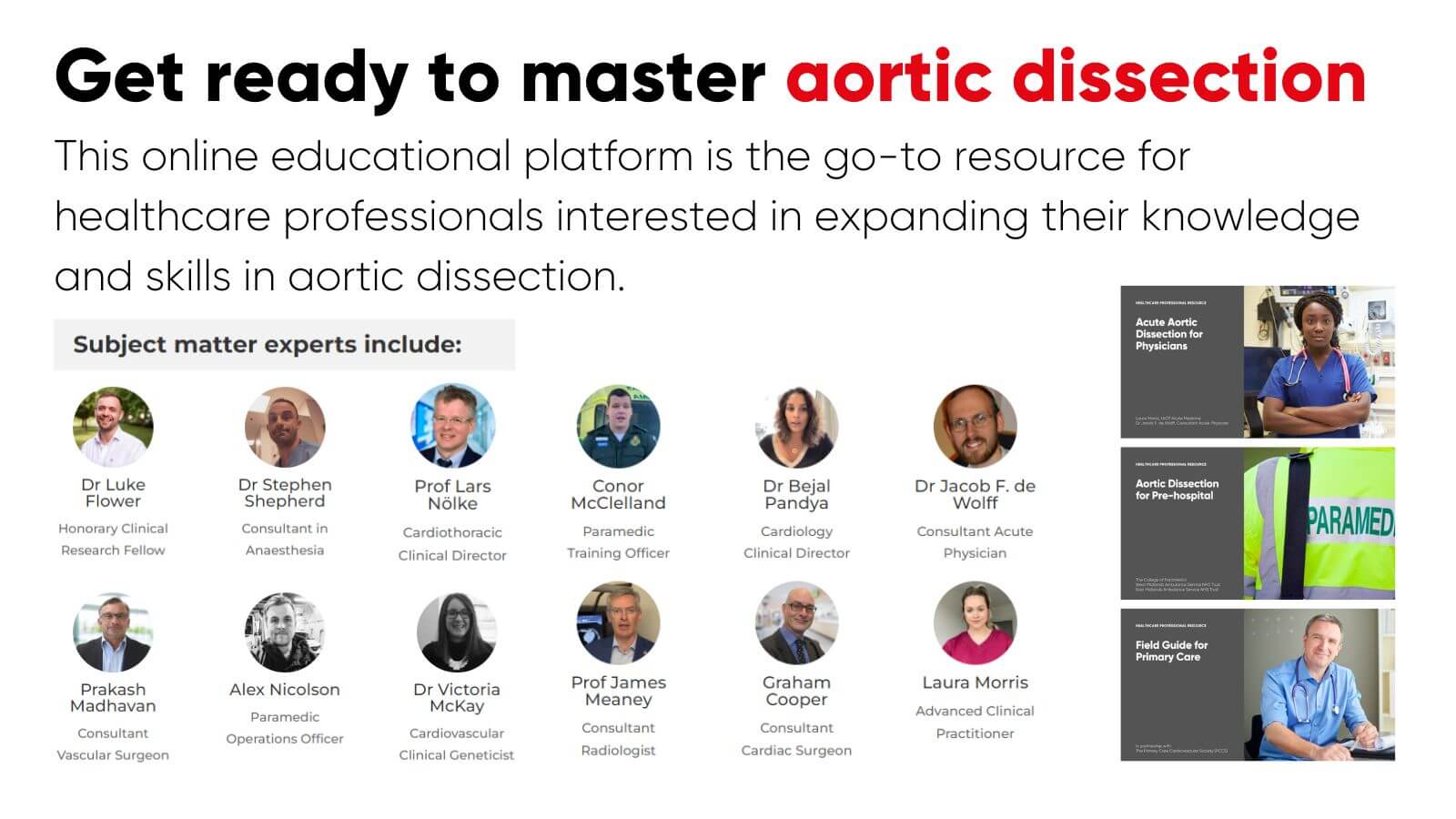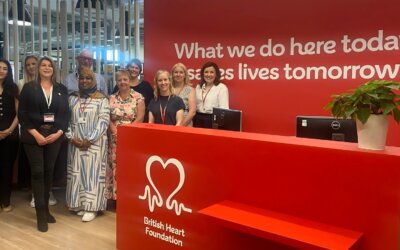The London Aortic Dissection Symposium, supported by The Aortic Dissection Charitable Trust and sponsored by Terumo Aortic, marked a significant milestone in the collective effort to advance the understanding and management of Acute Aortic Dissection (AAD). The event gathered an impressive 950 participants from 72 countries, emphasising the global importance of improving AAD care.
A Call for Collaboration
The symposium began with a passionate address by Professor Aung Oo, highlighting the necessity of a collaborative approach to improve outcomes for AAD patients. He acknowledged the visionary work of Dr Farhin Holia, whose dedication ensured that this event brought together a multidisciplinary team of experts. The focus on broadening perspectives beyond just surgical approaches underscored the event’s commitment to a comprehensive understanding of AAD care.
Distinguished Faculty and Expert Contributions
The symposium featured an esteemed panel of speakers, including renowned figures such as Professor Christoph Nienaber, cofounder of the International Registry for Aortic Dissection (IRAD), and Dr Michael Sabetai Chair of UKAS (United Kingdom Aortic Society). Each expert brought unique insights into the complexities of diagnosing, managing, and treating AAD, providing attendees with a well-rounded understanding of the condition.
Pathophysiology and Clinical Presentation of Type A Aortic Dissection
Ana Lopez-Marco, a consultant cardiac and aortic surgeon, presented an in-depth discussion on Type A Aortic Dissection, beginning with its pathophysiology. She explained how a tear in the intima layer of the aorta allows blood to enter the media, creating a separation of the layers and forming the true and false lumens. The differentiation between Type A and Type B dissections, based on the location of the primary tear, was highlighted as crucial for determining the appropriate management strategy.
Ana also detailed the various presentations of Type A dissections, which often masquerade as other conditions due to their diverse symptoms. She emphasised the importance of asking the question of whether it could be aortic dissection among emergency and primary care physicians to ensure timely diagnosis and treatment, thereby improving survival rates.
Diagnostic Challenges and Misdiagnosis: A Decadal Review
Dr Farhin Holia presented the Pan-London Decade-Long Analysis of Misdiagnosis of Acute Aortic Syndromes (PanDAMAAS). This review revealed alarming rates of misdiagnosis and delayed diagnosis, contributing to unnecessary mortality. Farhin underscored the need for a paradigm shift in how healthcare professionals approach AAD, advocating for improved diagnostic protocols and better education on the varied presentations of the condition.
Imaging Techniques: Enhancing Diagnostic Accuracy
Dr Deepa Gopalan, a consultant radiologist, discussed the critical role of imaging in diagnosing AAD. She emphasised the superiority of CT angiography due to its high sensitivity, specificity, and speed, making it the standard for initial diagnosis. Deepa also highlighted the challenges posed by artefacts and the importance of ECG gating in ensuring accurate imaging, particularly in the assessment of the aortic root and coronary arteries.
Pathophysiology of Type B Aortic Dissection
Dr Morad Sallam provided an insightful discussion on the pathophysiology and clinical presentation of Type B Aortic Dissection. He explored the complexities of the condition, noting that the presentation can vary significantly depending on the extent and nature of the dissection. Morad emphasised the importance of considering malperfusion syndromes and the role of advanced imaging in guiding treatment decisions.
Bridging the Gap: From Guidelines to Practice
Professor Christoph Nienaber gave a comprehensive overview of the current guidelines for AAD management and the challenges in translating these into clinical practice. He stressed the importance of defining the aorta as an organ, creating specialised aortic teams and establishing regional networks to ensure that patients receive the best possible care, regardless of where they present.
Life After Aortic Dissection: Patient Concerns and Lifestyle Considerations
Dr Bejal Pandya’s discussion centred on various aspects of life post-dissection, including the impact on family, lifestyle adjustments, and specific considerations such as exercise, driving, and flying. She highlighted the genetic implications of aortic dissection, particularly in families where conditions like Marfan syndrome or Loeys-Dietz syndrome are present. Bejal stressed the importance of understanding a family’s genetic history, advocating for a detailed family pedigree that includes at least three generations to guide clinical decisions about timing interventions.
These conditions, characterised by mutations in genes such as FBN1, have profound implications for both the individual and their family members. She put emphasis on the significance of regular updates to family histories in clinical settings and the critical role of multidisciplinary teams in managing these patients.
Exercise and Aortic Dissection: Safe Practices and Recommendations
A key area of Dr Pandya’s talk focused on exercise post-dissection. She distinguished between static and dynamic exercises, explaining that static exercises -such as heavy lifting – pose significant risks due to the substantial increase in blood pressure they induce. She recommended that patients avoid such activities, suggesting instead that they engage in dynamic exercises like swimming, cycling, and light resistance training, which are safer and beneficial for cardiovascular health. Bejal advised patients to perform exercises at about 80% of their maximum effort to avoid straining, which could exacerbate their condition.
Recreational Activities and High-Risk Behaviours
Dr Pandya also addressed concerns regarding recreational activities, including thrill-seeking sports like roller coasters and bungee jumping. She cited studies showing that while these activities can induce minor cardiac events in some patients, they may pose significant risks to those with a history of aortic dissection. Therefore, she advised caution and suggested that patients consult their healthcare provider before engaging in such activities.
Travel and Flying: Considerations for Aortic Dissection Patients
Another critical aspect discussed was the safety of flying after aortic dissection. Dr Pandya noted that while flying is generally safe, the hypoxia experienced at high altitudes can cause a modest increase in blood pressure. She recommended that patients take general precautions, such as staying hydrated, moving around the cabin, and ensuring they take their medications as prescribed. She also mentioned that, in the UK, commercial airline pilots with aortic dilatation are not permitted to fly, underscoring the seriousness of the condition.
Blood Pressure Management in Aortic Dissection: A Critical Aspect of Care
The session also included a detailed discussion by Dr Vikas Kapil on the management of blood pressure in patients with aortic dissection. Blood pressure control is vital in reducing aortic wall stress and preventing further damage. Dr Kapil laid emphasis on the use of beta-blockers as the first-line treatment and discussed the role of invasive blood pressure monitoring in ensuring accurate measurement. He highlighted the importance of starting oral therapy as soon as intravenous drugs have achieved the desired blood pressure control, thus facilitating a smoother transition out of intensive care.
Critical Care Transfers: Challenges and Best Practices
This presentation, by Dr Stephen Shepherd, addressed the logistics and challenges of transferring critically ill patients with aortic dissection to specialist centres. He spoke about the London Adult Critical Care Transfer Service (ACCESS), discussing the complexities involved in safely transporting these patients, and the importance of experienced teams and specialised equipment. Stephen also explored the physiological challenges posed by transport, such as managing blood pressure and preventing complications during transit.
Advances in Surgical Techniques
Professor Aung Oo, a central member of the faculty, provided a comprehensive overview of the surgical management of acute aortic dissection. His talk focused on the evolution of surgical techniques, particularly the use of the frozen elephant trunk procedure, which has become the gold standard for repairing acute type A aortic dissections. He discussed the benefits of this approach in terms of reducing mortality and improving long-term outcomes for patients. Professor Oo also addressed the importance of preoperative assessment, including the thorough examination of the entire aorta and its branches via CT aortogram, to guide surgical planning.
The symposium further explored the critical aspect of cerebral protection during aortic surgery, with Professor Oo detailing various strategies employed to safeguard the brain during circulatory arrest. These include the use of near-infrared spectroscopy (NIRS) for cerebral monitoring, as well as the administration of steroids and magnesium to reduce inflammation and protect the brain.
Overcoming Clinical and Logistical Challenges
The symposium also included discussions on the logistical challenges of managing acute aortic dissection cases, particularly in the context of large urban centres like London. Michael Sabetai, another key speaker, highlighted the importance of having a streamlined referral pathway and stressed the need for centres that are equipped to handle complex aortic cases. He discussed the variability in data collection and reporting across different centres, advocating for more standardized practices to improve outcomes.
The symposium was not just a platform for sharing clinical advancements but also a space for reflecting on the patient experience. Valerie, a survivor of a type A dissection, shared her personal journey, from the sudden onset of symptoms to the challenges of recovery. Her detailed story featured the importance of timely diagnosis and intervention, as well as the need for greater awareness and understanding of aortic dissection among both healthcare professionals and the public.
A Path Forward
The London Aortic Dissection Symposium successfully brought together global experts to share their knowledge and experiences, highlighting the critical need for collaboration in improving AAD outcomes. The event emphasised the importance of early and accurate diagnosis, the integration of patient perspectives, and the ongoing refinement of treatment strategies. As the symposium concluded, it was clear that the knowledge shared would have a lasting impact on the future of AAD care worldwide.






